Veteran of the Month: James “Bob” Laizure | July 2024
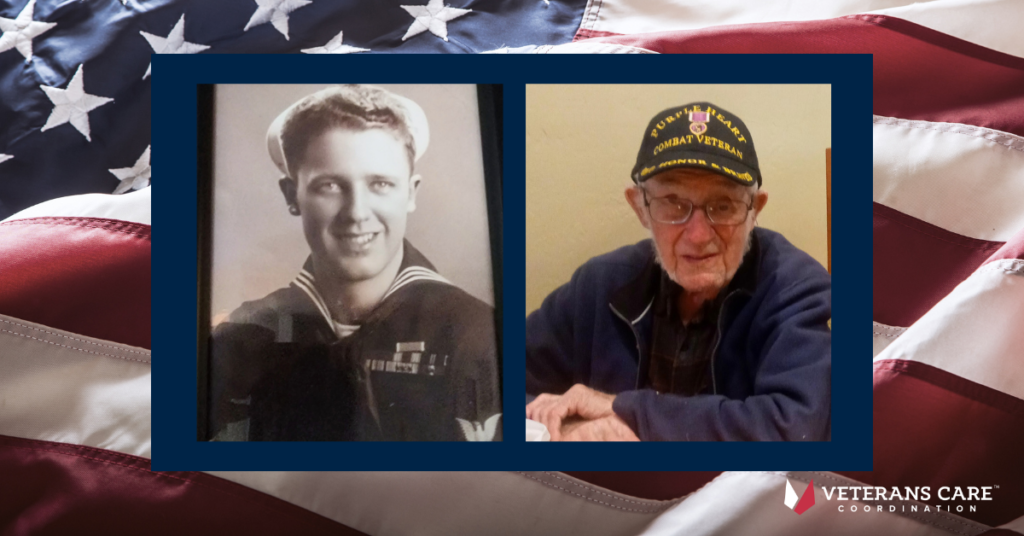 James Robert Laizure was born on his family’s farm in Cherokee County, Kansas, in 1924. Laizure, who went by Bob his entire life, is the oldest of seven siblings, all born in their home. Laizure explained that whenever a new sibling was going to arrive, the children were sent to wait in the barn while the doctor was inside assisting with the delivery.
James Robert Laizure was born on his family’s farm in Cherokee County, Kansas, in 1924. Laizure, who went by Bob his entire life, is the oldest of seven siblings, all born in their home. Laizure explained that whenever a new sibling was going to arrive, the children were sent to wait in the barn while the doctor was inside assisting with the delivery.
Growing up on a farm, Laizure shared that he didn’t really date as a young man, although he had plenty of female friends. He explained that they always had plenty of activities to keep them occupied. He described how everyone in the family would pitch in to help with chores, saying, “We did whatever needed to be done on the farm: milk the cows, slop the pigs, herded the sheep, had a garden and planted vegetables for fresh food, and butchered a pig once a year for meat from the pig. Just the normal farm life of the 1930s.”
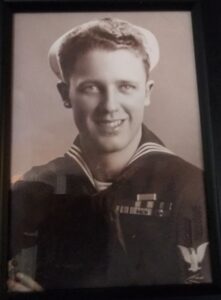
Bob Laizure
In 1942, while still in high school, Laizure was drafted by the United States Army. His father applied to the draft board for an exemption until he was 18. Laizure decided he wanted a choice on which branch he would be in, so he enlisted in the Navy, stating, “I did not want to have to carry a 90-pound pack on my back and sleep in a foxhole half full of water and carry a carbine. So that’s why I chose the Navy.” Laizure, who turned 18 on July 5th, continued, “So the summer after high school, I was gone; the Navy had me.”
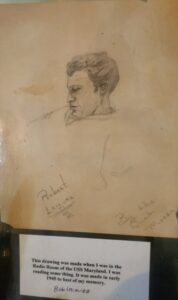
While sitting in the radio room on the USS Maryland in early 1945, a friend sketched his picture without him realizing it.
In the autumn of 1943, Laizure was sent to Farragut Naval Training Station near Coeur d’Alene, Idaho, for basic training. After completing his basic training, he began his Military Occupation School (MOS) for radio school, where he learned Morse code and radio communications. Laizure described, “After I got out of boot camp, I went to radio school and learned to be a radio technician. I just copied the messages down, really, and they were in code, and someone else decoded them.”
After completing his MOS in June of 1944, Laizure was sent to Honolulu to be stationed aboard the USS Maryland. The USS Maryland was on battleship row during the attack on Pearl Harbor in 1941 but was only lightly damaged. When Laizure arrived in Hawaii, the USS Maryland was undergoing repair in Pearl Harbor from a torpedo strike that occurred during the Battle of Saipan, so Laizure found himself in what he called “tent city.” Laizure recalled, “When I went aboard the ship, they didn’t put me in the radio gang; they put me in a division that manned a 20mm anti-aircraft gun until I finally got up enough courage to challenge them and tell them I was a radio man and wanted to be transferred. That took a while, so I spent some time shooting at airplanes.”
Laizure provided details about his role on the ship’s port side (left side) on Turret Two. The USS Maryland had four twin-gun turrets. Each turret was equipped with an anti-aircraft gun operated by three men: a loader, a gunner, and an unloader, with Laizure serving as the loader on Turret Two. Describing the turret as a gun with two barrels capable of holding two 16-inch diameter shells, Laizure vividly recalled, “We could see them going through the air as they fired them. You learned to know where to look, and you could see those black dots going through the sky.”
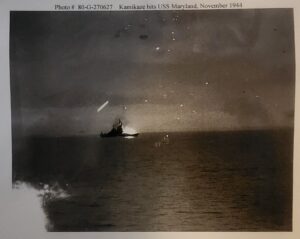
Photo #80-G-270627 Kamikaze hitting USS Maryland, November 1944.
In his account, Laizure vividly began to depict the events of the Battle of Leyte Gulf, widely regarded as the largest naval battle of WWII and possibly the biggest in history. He detailed the involvement of a total of 282 ships from Japan, Australia, and the United States and over 200,000 men. He emphasized the scale of the battle and the fact that they were all WWI battleships, stating, “We had the biggest sea battle ever. We went on for two days there at Leyte.” The Battle of Leyte Gulf consisted of four separate engagements, one of them being the Battle of Surigao Strait, where Laizure’s ship was involved in the sinking of a Japanese fleet. As part of the seventh fleet, Laizure explained, “Our main responsibility was to protect the soldiers and the noncombatant ships, and that was helping (General) MacArthur take over the Phillipian Islands and to destroy any target on the islands that the soldiers wanted destroyed.”

The USS Maryland refueling and loading, April 1945.
Approximately a month after the battle of Leyte Gulf, Laizure’s ship, the USS Maryland, was attacked by a Kamikaze suicide plane, which struck the ship where Laizure and his group were stationed. Laizure remembered, “We were at our battle stations, and I can remember looking up and seeing that plane coming down.” He witnessed the plane descend, ascend, and circle through the clouds before heading straight for them. Realizing it was going to hit them, he said, “When it got close, some of the guys ran, but I didn’t.” He had the idea that if he dropped down lower than the shield around the gun, the plane wouldn’t hit him, stating, “So that’s what I did. I dropped down, put my arms around my knees, and put my face in my arms.” At 19 years of age, Laizure had two thoughts: “I guess this is it,” and “I wonder what they will do with it.” Laizure explained that was the moment he thought he would be killed and wondered what his parents would do with the $10,000 life insurance policy they would receive. After that, Laizure lost consciousness. He has no memory of the plane hitting the ship or feeling the bomb go off. Three other men within ten feet of him who were standing up were all killed. Laizure stated he couldn’t remember how many men onboard were killed. According to warhistoryonline.com, the kamikaze attack crashed into the USS Maryland between Turrets No. 1 and 2, piercing the forecastle, main, and armored decks and blowing a hole in the 4-inch steel, causing extensive damage and starting fires. Thirty-one men were killed, and 30 more were wounded in the attack, including Laizure. Laizure noted that the bomb didn’t penetrate the hull, keeping the ship afloat. It did strike into the sick bay, which he explained was where most fatal injuries happened.
Laizure suffered 1st, 2nd, and 3rd-degree burns on his face, with the skin peeling off his nose. The area under his right eye was also burned, but fortunately, he doesn’t have any scars. For his injuries sustained that day, he was awarded a Purple Heart. He also received a Bronze Star with a “V” for Valor because, after the Kamikaze attack, as soon as he regained consciousness, he started to remove potentially explosive ammunition from the ship deck. He cleaned the decks and assisted in stretchering his injured shipmates to safety, using mattress covers in place of body bags for the fallen. Despite his injuries, he kept working and was considered part of “the walking wounded.” He has memory lapses from the time after the explosion and only realized years later that he had been knocked unconscious. He explained he wasn’t a Christian at that time and didn’t know much about God but credits becoming a Christian and reading the bible as his therapy after all he witnessed in war.
After the ship was repaired in port, the USS Maryland, with Laizure aboard, returned to sea. They missed one battle during the repairs but rejoined for the battle of Okinawa, where they were struck by yet another kamikaze attack. Laizure explained what he saw amid the chaos of the second attack: “He (the kamikaze jet) landed on top of Turret 3. At least four of them got killed because I remember seeing at least four bodies.” Laizure recalls talking to a crewmate responsible for extinguishing the fires on deck, who had to use the hose to put out fires on men in flames and wondered if he had done the right thing. Reflecting on those intense moments, Laizure exclaimed, “You did what you were taught to do, and I have to give God credit for everything that happened then.”
After returning to the States, Laizure, who had enlisted for a 6-year term, was later transferred from the USS Maryland to the 19th fleet in Bremerton, WA. While on duty there, he began using a teletype to print out messages due to the different radio equipment available. He came across a message suggesting that radiomen may be eligible for early discharge. Determined to pursue this option, Laizure informed his supervisor of his intention. Despite having almost three years of service left, he was eventually granted an early honorable discharge, which he waited for in Seatle. After receiving his discharge papers, he moved to California, where his parents had relocated from Kansas.
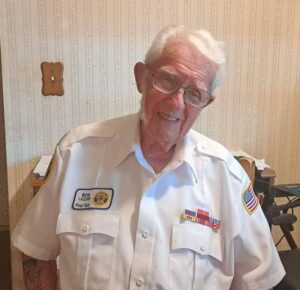
Bob Laizure, American Legion, post 133.
Once Laizure settled in California, he enrolled in school to train as a TV technician. During his time in school, Laizure had a couple of pivotal moments. He realized, while listening to different sound frequencies that he had a constant ringing in his ears from damage caused by the anti-aircraft weapons he operated in WWII. Laizure explained that even after many years, “It still is ringing in my head.” Laizure also met a fellow farm boy while in training who taught him about Christianity. With no Christian background then, he reflected, “All I knew about God was that he was someone who lived in the sky.” Laizure developed a strong faith and has tried to live as a good Christian ever since.
Laizure was introduced to his friend’s sister during her visit to Los Angeles from Chicago in the early 1950s. He kindly offered to help pick her up from the train depot since his car was spacious enough to carry her trunk. They started a friendship that blossomed into a loving 54-year marriage, raising three daughters. He now has grandchildren and great-grandchildren and cherishes the time spent with his family during their get-togethers.
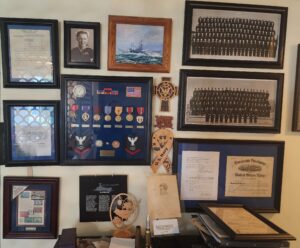
Bob Laizure’s collection of awards, memorabilia, and accolades from World War II.
Laizure not only worked as a TV technician but also found work with a computer manufacturing company before eventually opening his own janitorial supply business. The pastor at his church convinced him to sell it when he was 87 years old, and he finally applied for Social Security. When asked if he thought that continuing to work for so many years kept him young, he responded, “Yes, because you had an interest in things and wanted to satisfy the needs of your customers, but I had to admit I was reaching the age that it took more stamina than someone at that age had.”
In his retirement, Laizure keeps an active schedule, staying involved in various community activities. He is an active member of his church, serves on the board of the American Legion, and regularly meets with Christian groups on Fridays and Saturdays. Laizure, who stopped driving at the age of 90, expressed, “They come and get me and take me to these meetings. It is a group of men, and it is for us and our relationship with the Lord.” Laizure makes sure to be up by 4:30 am to eat breakfast and be ready to go when they arrive.
Even though he has spent many years as an active member and board member of the American Legion Post 133, he had never contacted the local VA for anything. At age 99, Laizure finally connected with the VA, and the first thing they did was get him hearing aids almost 80 years after his service.
When asked what he learned from his time in the service that carried over to civilian life, he responded, “Just to be responsible is the main thing there. You are responsible for your life and other people’s lives. Do what you can do. There are limits to your skills, but you can get things done and try to encourage people, help them, and pray for them.”
With Laizures 100th birthday approaching on July 5th, it’s heartwarming to know he’s received many invitations to parties and gatherings in his honor. He shared, “I joined the American Legion post here, and I get to ride in the Fourth of July parade in Huntington Beach with them. We also get to do other things together. And the Christian group that I meet with wants me to be involved in something there.” From the Legion to his church and his family, Bob Laizure will surely have a birthday filled with love and appreciation for all he has contributed.
Veterans Care Coordination is proud to recognize Bob Laizure for his service to our country. We are privileged to have the opportunity to share the stories of our nation’s heroes. Thank you for your service, Bob and Happy 100th Birthday.
Library of Congress Interview with James Robert Laizure, August 3, 2016
